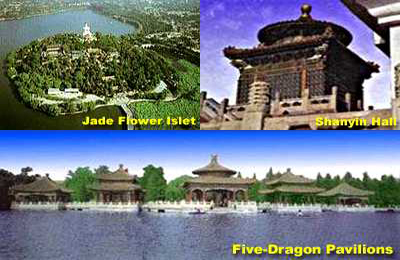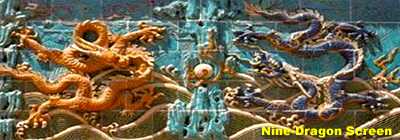 Beihai Park
Beihai Park
On the west side of the Forbidden City is a wide expanse of water called Tai Ye Chi. Tai Ye Chi is divided into three parts: Beihai Lake in the north, Zhonghai Lake in the middle, and Nanhai Lake in the south. Beihai, the best known of the three, was turned into a royal garden as early as 1,000 years ago.
The Designs of the three lakes can be traced to an ancient legend, which says that there were three celestial mountains in the Beihai Sea inhabited by immortals. Rulers took to constructing "celestial mountains" on the water space just outside the royal palace, turing legend into reality.
Jade Flower Islet
The small island is connected with the Circular City by Yong'an Bridge, A giant white pagoda rises on top of it. In summer lotus blossoms bloom in the lake surrounding the island.
Tuancheng (Circular City)
The small castle outside the southern gate of Beihai Park was built on a base of 4.6 meters high. It is surrounded by a circular wall of 276 meters long. The seclusive garden is decorated with palatial halls and pavilions and ancient trees
Chengguang Hall
The main structure in the Circular City has a square platform in front and a roof of several tiers of flying eaves. The roof is covered with glazed yellow tiles and edged with green glazed tiles. During the Ming Dynasty the emperor liked to come here to watch fireworks. It was converted into a Buddha hall during the Qing Dynasty. Now there is a Buddha statue of white jade in it.
White Pagoda
It was originally built in 1651 but collapsed in an earthquake. The present structure was a later reconstruction. The lamaist pagoda is 35.9 meters high with a tiered base and a body like an upturned bowl. Sutras in Tibetan language are carved inside the front gate. Fourteen copper bells hang from its copper canopy on top of which is a gilt ball like a flame.
White Jade Buddha
The statue in a niche in the rear part of Chengguang Hall is 1.5 meters high. It was carved out of a whole piece of jade. The crown and garment are of gold foil and inlaid with red and green crystals. Its left arm bears gashes made by swords, a result of the looting of soldiers of the Eight-Power Allied Forces who invaded Beijing in 1900.
Yong'an Bridge
The bridge linking the Circular City and Jade Flower Islet was built in the 13th century. Lotus flowers and petals are carved on its balusters and fence boards. Two archways stand on either side of the bridge.
Lacebark Pine
A story tells that Emperor Qian Long conferred on the tree the title of "White-Robed General". The ancient tree is still flourishing.
Jade Jar of Dushan
Carved out of a whole piece of jade 700 years ago, the jar weighs 3.5 tons. It was lost and retrieved in 1749, It bears exquisite carvings of dragons, water animals and clouds.
Shanyin Hall
South of the White Pagoda on Jade Flower Islet is the Yong'an Temple of Lamaism. The Shanyin Hall, a structure of glazed tiles in imitation of wood, is 4.4 meters wide. The round upper part is topped with a roof of copper tiles and a gilt ball. On the four sides of the square lower part there are 445 Buddhist statues of glazed tiles
Bronze Dew Plate
It is placed on a white stone terrace on the northern side of Jade Flower Islet guarded by white marble balusters. A bronze immortal perches on top of a stone pillar ornamented with a. twining dragon and holds with his hands the dew plate. It is said during the Qing Dynasty the emperor often used the dew collected in the plate to brew his medicine.
Long Corridor
The 300-meter-long corridor of two layers runs from Yiqing Tower to the east to Fenleng Pavilion to the west. It is a copy of the corridor in the Jiangtian Temple in Zhenjiang, Jiangsu Province. The corridor is a wonderful decoration of the landscape.
Jingxinzhai (Studio of Rested Heart)
It was built in 1759. Also known as Little Garden of Qian Long, it is the best garden in Beihai Park. The palatial halls, tranquil rooms, rockeries in strange shapes and a stream provide changing sights.
Liulige Tower
Looking west from Diecui Tower in Jingxinzhai one sees a high structure--the Liulige Tower. The four sides of the square tower are lined with glazed tiles and bear l,376 small Buddha statues, also made of glazed tiles.
They were built in 1543. The five waterborne pavilions are connected by zigzag bridges. The one in the middle is the largest. In old days the emperor and his consorts came here to fish, watch fireworks or admire the moon.
Guanyin Hall of Minor Western Heaven
Western Heaven in Buddhism is the Land of Extreme Happiness. Emperor Qian Long built the Guanyin Hall at Minor Western Heaven for his mother to pray for her happiness and longevity. It is the largest palatial hall in the style of a square pavilion in China. A plaque with the characters "Land of Extreme Happiness" in the handwriting of Emperor Qian Long hangs from the ceiling.
Jade Islet Stele
The towering ancient trees on the western slopes of Jade Flower Islet have created one of the Eight Views of Yanjing. It is known as "Jade Islet in Shady Springtime". The stele, erected in 1751, is inscribed with this phrase in the calligraphy of Emperor Qianlong of the Qing.
Nine-Dragon Screen
Made in 1756, the screen wall is five meters high, 1.2 meters thick and 27 meters long. The whole thing is built with glazed color bricks. On either side of it there are nine dragons, also made of glazed bricks, each playing with a pearl amidst waves of clouds.
|

